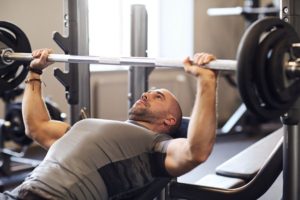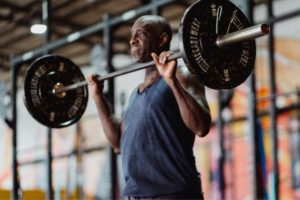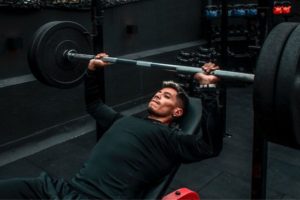Overhead press and incline bench press are great exercises for training the upper body.
As two variations of the bench press exercise, they target different muscle groups. These are two shoulder exercises for gym trainers of all levels.

To find out the best one for you, let’s compare the two bodybuilding exercises.
The Overhead Press
Also known as shoulder press, this is an upper-body weight training exercise. Here, the lifter presses a weight overhead while either seated or standing.
The overhead press is great for increasing the strength and size of the shoulder’s muscle mass. It can be used to increase the triceps muscles and the trapezius muscles.
Incline Bench Press
The incline bench press is a variation of the traditional bench press exercise.
It targets the upper portion of the pectoral muscles (chest muscles) along with the front deltoids (shoulders) and triceps. In this exercise, the bench is set at an inclined angle.
This is typically between 30 to 45 degrees, which places the lifter in a semi-upright position.
Comparing the Overhead Bench Press and Incline Bench Press
While they share similarities, there are key differences between the two exercises. This is in terms of technique and the emphasis they place on different muscle groups.
The Primary Muscle It Targets
Overhead Press: The overhead press primarily targets the deltoid muscles (shoulders), specifically the anterior (front) and medial (side) heads.
It also engages the triceps and upper chest to a lesser extent. Overhead Press helps build muscle mass as it targets the shoulders and arms.
Incline Bench Press: The incline bench press primarily targets the upper pectoralis major (upper chest) along with the anterior deltoids.
It also engages the triceps and front deltoids to a lesser degree. It can contribute to overall chest development and provide variation in chest training.
Range of Motion

Overhead Press: The overhead press involves lifting the weight from shoulder height to full extension overhead.
This makes it a compound movement that requires stability and mobility in the shoulder joints.
Incline Bench Press: The incline bench press involves lying on an incline bench (usually at a 45-degree angle).
Afterwards, you press the weight from the chest to full extension. The range of motion is shorter compared to the overhead press.
Technique
Overhead Press: The overhead press is performed by lifting a weight from shoulder level to an overhead position.
Then, extend the arms fully. You should engage your core muscles, keep your chest up, and maintain a neutral spine throughout the movement.
As you press the weight overhead, keep your head aligned with your spine and avoid leaning back excessively.
Incline Bench Press: The right way to do an incline bench press involves lying on an incline bench.
This is usually set at an angle between 30 and 45 degrees. Then, pressing a weight from the chest level up towards the ceiling.
Stay on the incline bench with your feet planted firmly on the floor. Ensure your back, shoulders, and head are in contact with the bench.
Equipment and Setup
Overhead Press: The overhead press can be performed with a barbell or dumbbell. It typically requires a barbell rack or a set of dumbbells and can be done standing or seated.
Incline Bench Press: The incline bench press is usually performed with a barbell or dumbbell on an adjustable incline bench set. It is placed at an angle between 30 to 45 degrees.
NOTE
If you’re new to the incline bench press, start with lighter weights. You can gradually increase your weight as you become more comfortable and stronger.
Stabilized Muscle Involvement
Overhead Press: The overhead press requires greater stabilization throughout the body.
Particularly in the core, lower back, and legs, to maintain proper form and balance during the movement.
Incline Bench Press: The incline bench press also requires stabilization but to a lesser degree compared to the overhead press.
This is because the back is supported by the incline bench.
The Primary Benefits
Overhead Press: The overhead press develops strength and stability in the shoulders. This is because your abdominal and lower back muscles will be engaged as stabilizers.
It also enhances shoulder mobility and improves overall upper-body pushing strength. It can also have carryover benefits for other pressing movements.
The overhead bench press requires core stability to maintain proper posture and balance throughout the movement.
Bench Press: The bench press is renowned for building chest strength and size. Besides this, it improves upper body pushing power.
It also engages the triceps and contributes to overall upper-body muscular development.
Both exercises could also help with straightening out your posture.
They do this by strengthening the muscles responsible for maintaining proper alignment and stability in your upper body.
Functional Applications

Overhead Press: The overhead press mimics movements such as pushing objects overhead.
It is relevant for activities like lifting objects, performing overhead sports movements, and certain athletic activities.
You can improve your functional strength for tasks like lifting objects overhead or in sports such as basketball or volleyball.
Bench Press: The bench press is commonly associated with strength training, powerlifting, and bodybuilding.
It can be useful for activities that require horizontal pushing or pushing objects away from the body.
Overhead Press or Incline Bench, Which Is Better?
Both exercises have their benefits and can be valuable additions to a bodybuilding routine. They each have their place in a well-rounded strength training program.
The choice between them depends on individual goals, preferences, and specific areas of focus.
It is often beneficial to incorporate both exercises into a well-rounded training program to target different muscle groups and achieve overall upper-body development.
Both aid a more comprehensive training stimulus for overall upper body strength and development.
Additionally, it’s important to perform exercises with proper form and technique to minimize the risk of injury and maximize results.
Consulting with a qualified fitness professional can provide personalized guidance based on individual needs and goals.
When deciding between the overhead press and the incline bench press for your bodybuilding routine, here are several factors to consider to make an informed choice:
Consider Your Specific Training Objectives
Are you primarily focusing on developing shoulder strength and size? Or are you looking to emphasize upper chest development?
Understanding your goals will help you prioritize one exercise over the other.
Muscle Emphasis
Both exercises target different muscle groups to varying degrees. If you want to prioritize shoulder development, the overhead press is an excellent choice.
If you’re looking to prioritize upper chest development, the incline bench press is more effective in engaging the upper pecs.
Variety in Training
Variety in your workout routine can be beneficial for muscle growth and preventing plateaus.
Incorporating both exercises into your routine at different times can provide a well-rounded approach to upper body development.
Individual Body Make-up
Everyone’s body has unique biomechanics and joint structures. Some individuals may find one exercise more comfortable or effective for their body type and joint health.
Also, when it comes to bodybuilding, other factors like your diet should be considered aside from exercise.
Final Verdict
There’s no definitive answer as to which exercise is better for bodybuilding. You can incorporate both exercises into your routine.
Alternate between them to target different muscle groups and add variety to your training.
As always, it’s recommended to seek guidance from a qualified fitness professional or trainer. They can ensure proper form and technique while performing the exercises.

Some people collect expensive old cars, and I’m into collecting bikes. I have 15 different bikes: special mountain bikes, sportbikes, professional, amateur, and city bikes. My friends and colleagues call me a ‘bike expert’ because I give advice on how to choose the right bike.
I’m also a massive fan of gym culture and heavyweight workouts. I met Alan at my local gym, and we’ve become friends quite soon. His idea of starting a sports blog seemed interesting to me, so I agreed to help.





